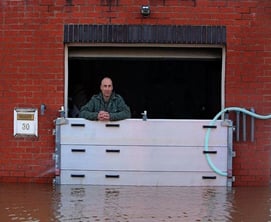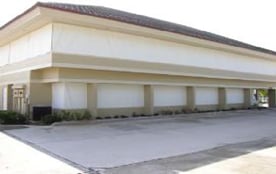Public Assistance Grant Program
The objective of the Federal Emergency Management Agency's (FEMA) Public Assistance (PA) Grant Program is to provide assistance to state, tribal, local governments and certain types of private non-profit organizations so that communities can quickly respond to and recover from major disasters or emergencies declared by the president. The State of Florida manages this program as the grantee from FEMA (grantor) for all sub-grants awarded to local eligible jurisdictions and agencies within the State of Florida.
Through the Public Assistance Grant Program, FEMA provides supplemental federal disaster grant assistance for debris removal and emergency protective measures. In addition, grant assistance may be provided for the repair, replacement or restoration of disaster-damaged, publicly owned facilities and the facilities of certain private non-profit (PNP) organizations. To be eligible for assistance from this grant program, prospective applicants must fill out aRequest for Public Assistance (RPA) through the State of Florida’s Public Assistance Web Portal, www.FloridaPA.org. The FEMA Public Assistance Grant Program also encourages protection of the damaged facilities from future events by providing assistance for hazard mitigation measures during the recovery process. In accordance with the Robert T. Stafford Disaster Relief and Emergency Assistance Act, the federal share of assistance is not less than 75% of the eligible cost for emergency measures and permanent restoration.
Prior to the Public Assistance Grant Program becoming available, a presidential declaration must be made designating the jurisdictions eligible for Public Assistance. In preparing to request a presidential declaration, the Florida Division of Emergency Management (FDEM) will participate in a joint FEMA, state, and local jurisdiction Preliminary Damage Assessment (PDA) to determine state eligibility for a presidential declaration for the Public Assistance Grant Program. The PDA process assesses the costs associated with Emergency Protective measures, Debris Removal, and Infrastructure Restoration to pre-disaster condition after deductions for insurance and any other federal program payments are made. If the total of these costs for both the affected counties and the state exceed the amount of assistance the state is able to provide, as established by the current fiscal year threshold developed by FEMA based on adjustments to the consumer price index, the incident may then become eligible for a Public Assistance declaration. It is for this reason that all damages must be tabulated to capture the true cost of the incident to the state for consideration by FEMA and the president.
To apply for Public Assistance, eligible applicants must be a registered user in Grants Portal and submit a Request for Public Assistance (RPA). To receive assistance, all eligible applicants will be required to submit this form through Grants Portal within 30 days of a Presidential Disaster Declaration, unless a deadline extension is issued.
For instructions on becoming a registered user in Grants Portal and instructions for current registered users to submit a RPA, view Submitting a Request for Public Assistance.
Public Assistance is categorized into two types of work: Emergency and Permanent. The performance period for Emergency Work Public Assistance Grants is normally within 6 months after the presidential declaration. The performance period for Permanent Work Public Assistance Grants is normally within 18 months after the presidential declaration. The performance period of both of these types of grants can be extended provided an appropriate request for extension is submitted to the state (grantee) by the local jurisdiction or agency (sub-grantee). Requests for extension of performance period are submitted through the State of Florida’s Public Assistance Web Portal, www.FloridaPA.org.
Following a Presidential Disaster Declaration, the Federal Emergency Management Agency's (FEMA) Public Assistance (PA) Grant Program provides assistance for qualifying state and local governments by paying part of the costs of rebuilding a community's damaged infrastructure. FEMA may cover up to 100%, but no less than 75%, of approved project costs. In cases where the PA Program provides less than 100% of the approved project costs, the acceptance of financial assistance on the part of the state is contingent upon a requirement for matching funds. In such cases, the state will provide the entire required match amount for state agencies and one-half of the required match for grants awarded to local governments.
In extreme cases of hardship, eligible subgrantees have the option of applying for a waiver of the required match amount. Per section 252.37(5)(b), Florida Statutes:
The Executive Office of the Governor (EOG) may approve a waiver, subject to the requirement for legislative notice and review under s. 216.177, of all or a portion of the required match for public assistance projects for local governments if the Executive Office of the Governor determines that such a match requirement cannot be provided, or that doing so would impose a documented hardship on the local government, and if the local government applies for the wavier within the first 18 months after the disaster is declared.
Subgrantees may also request a deferral of payment for their required match. In cases where a payment deferral is granted, a schedule for repayment will be developed between the subgrantee and the EOG Office of Policy and Budget.
Requests will be reviewed with consideration to the following:
- Demographics: population size, poverty rate, unemployment rate;
- Storm Impacts: number of storms, severity of impact, non-FEMA reimbursable expenditures; additional hurricane recovery/mitigation funding granted, frequency of prior disasters, other assistance available;
- Tax/Revenue Capacity: millage rate, is the entity at maximum millage, are all utility taxes levied, can millage be increased to cover costs, per capita taxable value, fiscally constrained county,
- Special Designations: financial distress, Rural Area of Critical Economic Concern;
- Financial Information: general fund reserves, revenues and expenditures of the entity, number of months of reserve in general fund, the local match requirement as a percentage of the general fund balance; and
- Other Considerations: unique to the local government.
Subgrantees interested in applying for a waiver or deferral of payment of their local match will need to submit an Application for Disaster Assistance Local Match Reduction or Waiver and Payment Deferral for Public Assistance form and all required documentation listed in the application to:
Executive Office of the Governor
Office of Policy and Budget
The Capitol, Room 1802
Tallahassee, Florida 32399-0001
Attn: Brian Mimbs, Policy Coordinator
For a copy of the complete guidelines for analyzing and approving applications from local governments requesting a match reduction or waiver and payment deferral, view Request for Waiver of Local Match Following a Disaster.
Often the best time to mitigate public facilities from future disaster damages is during recovery. If a facility qualifies for Public Assistance (PA) funding for permeant work, it may also be eligible for hazard mitigation measures. Mitigation measures are defined as any sustained action taken to reduce or eliminate long-term risk to people and property from natural hazards and their effects. Post disaster mitigation can minimize future loss to damaged facilities with PA Mitigation funding, also known as PA 406 Mitigation. Unlike FEMA’s Hazard Mitigation Assistance (HMA) grants, PA Mitigation is non-competitive and there is no overall funding limit. The available mitigation funding for a PA permanent work project depends on the estimated cost of the repair and the vulnerability of the damaged facility. More information can be found in FEMA Public Assistance Program and Policy Guide V4.
PA Mitigation Eligibility
PA Mitigation is only available for eligible PA permanent work projects: Categories C-G, which may include mitigation. Damages must be a result of a declared disaster and proposed mitigation measures must meet four eligibility criteria (based on FEMA Public Assistance Program and Policy Guide V4) :
1.The mitigation measures must directly reduce the potential of future damage to the damaged portion(s) of the facility.
2. The mitigation measures must be cost-effective, by meeting one of the following criteria:
- The cost of the mitigation measure does not exceed 15% of the total eligible repair cost of the facility or facilities for which the mitigation measure applies, OR
- The cost of the mitigation measure does not exceed 100% of the total eligible repair cost of the facility or facilities for which the mitigation measure applies AND is specifically listed in Appendix J: Cost-Effective Mitigation Measures of the FEMA Public Assistance Program and Policy Guide V4, OR
- The recipient or applicant demonstrates through an acceptable benefit-cost analysis (BCA) methodology that the measure is cost effective. FEMA’s BCA software provides appropriate BCA methodologies.
3. The mitigation measures must be technically feasible
4. The mitigation measures must be compliant with federal laws, regulations, and Executive Orders.
Cost Share
Projects are funded by a combination of federal and non-federal sources. The federal share is based off the PA cost share determined for that disaster and federal funds cover a minimum of 75 percent of eligible costs. Any remaining eligible costs are derived from non-federal sources (e.g., state, community, nonprofit, or in-kind donations).
How to Identify Hazard Mitigation Opportunities
Hazard mitigation measures are identified at a damaged site during or before the PA site inspection and captured through a Hazard Mitigation Proposal (HMP). The HMP is simply a proposal to reduce future damages at a site through hazard mitigation. The HMP consists of a scope of work and cost estimate of the repairs needed to prevent similar damage from happening again. If the HMP is approved, it is attached to the PA Project and modifies the total scope of work and cost. If you are currently recovering from a disaster, contact your assigned FEMA Public Assistance Program Delivery Manager (PDMG) for more detailed information. Please find more information in the FEMA Public Assistance Program and Policy Guide V4 or for more general information on PA Mitigation please view the FEMA PA 406 Mitigation Brochure.
When to use PA Mitigation vs HMGP (404)
As you are trying to decide where to allocate your funds, try to maximize PA Mitigation funding to the fullest extent possible for mitigation measures on damaged facilities eligible for PA permanent work before trying to utilize HMGP (404) on facilities. This preserves HMGP funding for other projects.
| Where does PA Mitigation work best? | Where does HMGP (404) work best? |
| Public facilities that are damaged by a declared disaster. | Vulnerable public facilities that are undamaged. |
| Eligible public and private nonprofit facilities. | Public and private properties, including private nonprofit facilities. |
| Damaged facilities in a declared disaster county. | Statewide projects for any type of hazard prioritized by the State |
| Example: Flood wall installed around a damaged hospital facility. | Example: Buyout of private homes in a flood prone neighborhood. |
Flood Mitigation Measures
|
|
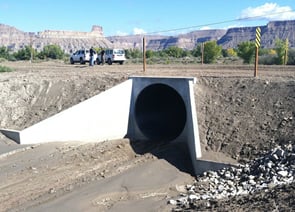 Upsized culvert with wingwall and |
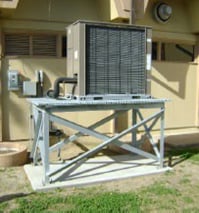 Upsized culvert with wingwall |
|
|
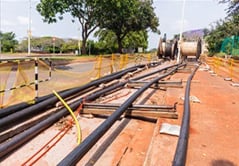 Underground Electric Lines |
|
Other Hazard Mitigation Examples
|
|
FAQs
What is hazard mitigation?
Hazard mitigation is any sustained action taken to reduce or eliminate the long-term risk to human life and property from hazards. Hazard mitigation funding is available from FEMA through the Public Assistance (PA) Program and the Hazard Mitigation Assistance (HMA) Program. Eligibility criteria, policies, procedures, and timelines for implementation of the hazard mitigation measures funded under the HMA grant programs differ from the hazard mitigation measures funded under the PA Program.
Why should I pursue mitigation?
Hazard mitigation projects reduce the loss of life and property by lessening the impact of disasters. Mitigation is a great investment, providing an average of $6 in savings for every dollar invested. Mitigation investments provide protection for facilities from future disasters, allowing critical facilities to maintain continuity of services during and after disaster events. Mitigation allows communities to build resilience and reduce the overall impact of future disasters.
What types of projects are eligible for Public Assistance Mitigation funding?
PA Mitigation may be possible on any PA eligible permanent work (Categories C-G) project. There are many mitigation measures eligible for PA Mitigation funding, depending on the type of facility and disaster. Examples include increasing the size of drainage culverts, undergrounding powerlines, wet and dry floodproofing of buildings, and strengthening materials for wind resistance. FEMA includes a list of cost-effective measures in the Public Assistance Program and Policy Guide Appendix J, although this list is not exhaustive, and many other methods may qualify.
Where can I find more information about Public Assistance Mitigation?
For more detailed guidance please view the Public Assistance Program and Policy Guide V4, or for general information on PA Mitigation please view the FEMA PA 406 Mitigation Brochure or visit the FEMA PA Mitigation webpage.

